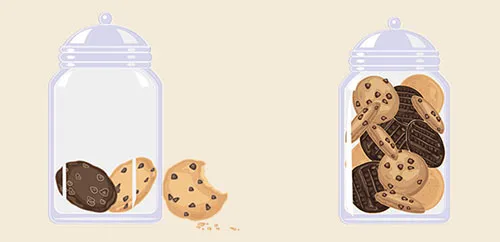

How To Get More Online Bookings | #1 Scarcity Marketing
Welcome to our brand new series that aims to help businesses, regardless of size and industry, to get more online bookings, boost repeat business and increase profitability.

Increase online bookings with scarcity marketing
As a business owner, you probably face difficulties filling up your calendar with new appointments all-year-round. Every industry has its silly season when even the most established businesses struggle to bring in the number of clients that they need just to break even.
In the coming months, I’ll share actionable advice and examples on how to increase bookings month-on-month in order to fill up your calendar with appointments throughout the year.
In this first episode, we will talk about how to get more online bookings with scarcity marketing. Here’s what we’ll cover:
- What is scarcity marketing
- 3 brands that used scarcity marketing in their campaigns
- How not to use scarcity to market your business
- Tips on how to get more online bookings with scarcity marketing
Are you excited yet? Without further ado, let’s dive in!
What is scarcity marketing?
Scarcity marketing is based on an economic term, the scarcity principle, which explains the correlation between dynamic supply and demand. When a good has low supply and high demand, its price increases and vice-versa. Consumers often place a higher value on goods that are scarce, whilst abundance can push down the value.
How does this work in practice? In 1975, a psychologist called Stephen Worchel studied the effect of scarcity. He offered subjects with cookies from two jars, one of which was full and the other had only two cookies in it. The subjects were told that there was a mistake: the cookie factory produced too many of one of the biscuits and too little of the other. The vast majority of subjects chose the jar with only two cookies.

Source: Optinmonster
The low supply and high demand triggered people to assign a higher value to the cookies in the second jar and made them more desirable. Since this experiment, marketers around the world have perfected the art of scarcity marketing and often use this tactic to make a product or service more desirable.
3 brands that used scarcity marketing in their campaigns
Nintendo
Back in 2006, Nintendo released its iconic home gaming console, the Wii. On its official release date in November, consumers lined up in front of the stores with theWii in stock to get their hands on one.
The stock was kept low for months so it would become a scarce good and encourage customers to make quicker decisions. Of course, the supply eventually caught up with demand, and by this time Nintendo has already sold 48 million Wii consoles.
You can’t really tap into the most popular marketing tactics without mentioning Google, can you? In 2011, when Google introduced its very own social media network, Google+, as a (late) response to Facebook’s fast-growing popularity.
In the first weeks of Google+, people could only join the network if they were invited by Google or a friend who already had a profile. After the first two weeks, the new social network had already gained 10 million users. When the gates opened for everybody with a Google account, the flow of new users wasunstoppableand by the first anniversary of Google+, 400 million people held an account.
Now that we know that Google is shutting down Google+ due to its unpopularity, this use case of scarcity marketing looks questionable, so whilst it did work back then,the growth was unsustainable. This is an example of how scarcity isn’t enough on it’s own..
Starbucks
Unicorn Frappuccino. Just two words and we all know which campaign I’m referring to.
In 2017, the beginning of the ongoing unicorn-mania, Starbucks came up with the “color-changing, flavor-changing and potentially life-changing” drink, the Unicorn Frappuccino.
I’m positive that this drink would have done amazing without any further marketing tactic, but Starbucks decided to throw in a scarcity bomb and announced that this incredible drink will only be available for a few weeks. After the announcement, the colorful coffee went viral.
And just like that, it disappeared, maybe forever?
How not to use scarcity to market your business
Invoking scarcity marketing, like all marketing strategies, has its flipside and overusing or misusing this tactic can backfire.

Source: Giphy
First of all, only implement this strategy, when it is truly applicable, so when you are really running out of stock or your available appointments to a certain service are filling up quickly. Using scarcity to sell something that is actually in abundance is not only shady, but if people find out about the trickery, it can push them away - maybe forever.
Second, don’t call undersupply all the time - even if it’s true. If your clients see ‘Limited number of Appointments’ all the time they will become immunized. Besides, they will think it might be untrue. Be honest about scarcity and use it in moderation.
Finally, don’t present a low-value product or service as scarce. Low supply will cause your customers to suspect a high demand and, therefore higher value, as a reason for undersupply, and will be expecting something extraordinary. The disappointment of receiving something of poor quality will definitely put them off of doing business with you ever again.
How to get more online bookings with scarcity marketing
Now that we know what scarcity marketing means, how it looks when big brands implement it and what are the don’ts of this tactic, let’s see how can you get more online bookings by applying actionable tips to your business.
1. Create an offer with a deadline
Creating a ‘Limited Time Only’ offer can help you encourage decision making, as enquiries will have to face a deadline and either act quickly or actively choose to miss out.
Let’s say that you are a Pilates instructor with a class that your clients really enjoy and you’d like to turn them into loyal customers who visit other classes as well. You could either create an offer that allows people to participate in the first class free of charge, or allow clients to purchase a series of bookings for a lower price.
The limited offer will help potential clients make a decision quicker which will speed up converting newbies into loyal customers.
2. Create a limited availability offer
Limited availability is different from limited time offers as, in this case, you offer a certain amount of available slots that can run out in a day or a week and it’s unclear when the slots will be gone, whereas limited time offers have a clear deadline. This promotion type works best with products or services that likely will never be available ever again.
For example, if you are a solo nail technician, you might have pounced on a limited edition designer nail polish that you will likely never have in your salon again. You can shout out to your clients to let them know that the stock you have is only enough for 15 customers. Make sure you have a correct estimate in order to avoid the awkward situation of running out before you can deliver the work for all the clients who booked with you.
3. Set up a seasonal promotion
Black Friday is probably the first thing that comes to mind when talking about seasonal offers, however, Valentine’s Day, Halloween or Christmas are just as easy to find a suitable offer for.
For a beauty professional, who has a well-established clientele, a reasonable offer can be a great opportunity to mix things up and lure in new customers. I could imagine that a beautician could offer a pumpkin face treatment around Halloween. A hairdresser could offer highlights for singles who want to pamper themselves around Valentine’s Day. You get the idea.
This is an exciting and creative way to use scarcity marketing in your business, and it is less bold than the other ones, so it can be a good way for you to ease into this tactic.
4. Use social proof
Creating a limited offer is only 20% of the work, promoting it is the other 80%. Social proof is an extremely effective method of showcasing the popularity of your services. The more genuine the social proof is, the bigger the impact will be.
Displaying reviews or a star rating on your website and across your social media profiles reassures potential clients that your services are already popular, which lowers the risk they will have to take when booking with you.
Another great way to showcase the demand for your services is to post about new clients or new bookings to social media. I know this may seem time consuming and too much work, however, you can easily automate this.
For example, you can use Zapier to set up a zap that creates a new post on Facebook or tweets whenever a new booking is placed in your online booking calendar. Here’s how to do this:
- Select 10to8 Online Booking as the app that triggers the process
- As a trigger, choose ‘New Appointment Is Booked’
- Now choose your preferred social media platform
- Choose an action like ‘Create new tweet’
- Write the copy of your post and don’t forget to include the URL of your 10to8 booking page
- Test the zap and you’re done!
To make this even easier for you, we have already set up this zap template, and I’ve written a post copy that will maximize the effect of the post.
Set up the 10to8 Online Booking & Facebook integration here
Set up the 10to8 Online Booking & Twitter integration here
Wrapping up
It’s not easy to run your own business and make sure that you’re calendar is always packed full with appointments. But we are here to help and there are four more episodes to come, with actionable tips on how to get more online bookings and a surprise in the last episode.
If you don’t want to miss out on the upcoming articles with great tips, visit our blog here.





